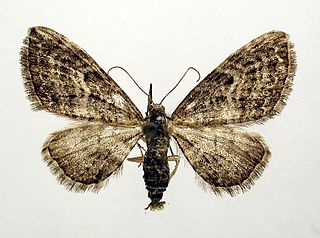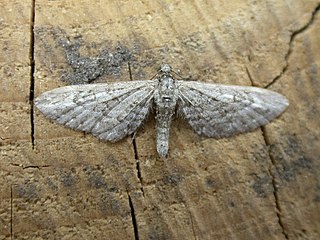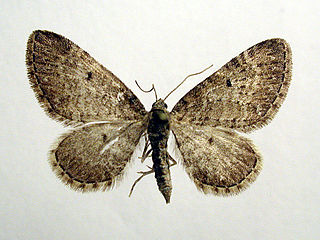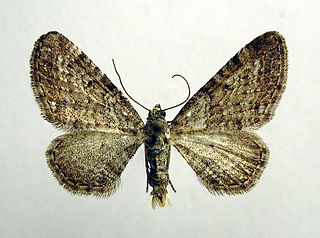
Eupithecia is a large genus of moths of the family Geometridae. There are hundreds of described species, found in all parts of the world, and new species are discovered on a regular basis.

The lime-speck pug is a moth of the family Geometridae. It is a common species throughout the Palearctic region, the Near East and North Africa.

The common pug(Eupithecia vulgata) is a moth of the family Geometridae. It is a common species across the Palearctic region, including the Near East and North Africa. It ranges from the Atlantic coast of Ireland and Portugal across Europe, the Middle East and Central Asia to the Russian Far East (Priamurje) and Korea.

The juniper pug or juniper looper is a moth of the family Geometridae. The species was first described by Michael Denis and Ignaz Schiffermüller in 1775. It is found throughout the Palearctic and in the Nearctic.

In Hinduism, an astra was a supernatural weapon, presided over by a specific deity and imbued with spiritual and occult powers that caused its effect or impact. Later the word came to denote any weapon which was used by releasing it from one's hand (e.g. an arrow, compared to keeping it one's hand e.g. a sword. In Ramayana and Mahabharata, Rama had more astras than any other warrior. Various texts have stated that Arjuna possessed almost all astras except Narayanastra.
Miya (Miyawa) is an Afro-Asiatic language spoken in Bauchi State, Nigeria. It is also referred to as "vә́na mίy" translating to "mouth of miy". There are approximately 5,000 speakers of Miya. It is related to languages such as Hausa, which the Miya people sometimes borrow from.

Vana-Roosa is a settlement in Rõuge Parish, Võru County in southeastern Estonia. It contains a church, manor house and lake.

Vana-Saaluse is a village in Võru Parish, Võru County in southeastern Estonia. Between 1991–2017 the village was located in Vastseliina Parish.

The larch pug is a moth of the family Geometridae. The species can be found in Europe, the Ural Mountains, West and Central Siberia, the Altai Mountains, Transbaikalia, Yakutia, the Far East, Mongolia, Korea, Japan and in North America, from Yukon and Newfoundland to New York and Arizona.

Eupithecia nanata, the narrow-winged pug, is a moth of the family Geometridae. The species was first described by Jacob Hübner in 1813. It can be found all over Europe including Russia and Ukraine. In the Alps it occurs up to 2,200 metres (7,200 ft) above sea level and in the Pyrenees to 2400 meters. The species prefers dry or boggy heathlands.

Eupithecia venosata, the netted pug, is a moth of the family Geometridae. It was first described by Johan Christian Fabricius in 1787. It is found across the Palearctic realm from Portugal and Morocco in the west to the Lake Baikal in Siberia and Afghanistan and Pakistan in the east.

Eupithecia satyrata, the satyr pug, is a species of moth of the family Geometridae. It was described by Jacob Hübner in 1813. It is found from Ireland, through northern and central Europe east to all of Russia and central Asia and western Siberia to Tibet. It is also present in North Africa and North America.

Eupithecia pernotata, or Guenée's pug, is a moth of the family Geometridae. The species was first described by Achille Guenée in 1857. It is known from the Alps, through Romania to southern Russia. It is also found in Finland.

The World Esperantist Vegetarian Association is a voluntary association of Esperanto-speaking vegetarians. Founded in 1908, the group's working language is Esperanto, and it is the oldest international organization of vegetarians that is currently active. TEVA published a journal, Vegetarano ("Vegetarian") from 1914 to 1932, revived in 2009 as Esperantista Vegetarano, and has also operated a spirited Internet mailing list through Yahoo! Groups since 2005.

Eupithecia quadripunctata is a moth in the family Geometridae. It is found in India, Pakistan, Nepal, Russia, China, Taiwan, Korea, Japan and northern Thailand.
Eupithecia variostrigata is a moth in the family Geometridae. It is widespread in the western Palearctic realm, ranging from Spain to the western Pamirs in the east.

Vana-Antsla is a small borough in Võru County, in southeastern Estonia, located about 4 km (2 mi) north of the town of Antsla. As of 2011 Census, the settlement's population was 181.

Vana is a village in Bala Larijan Rural District, Larijan District, Amol County, Mazandaran Province, Iran. At the 2006 census, its population was 304, in 89 families.
Vana is a town and minor former Rajput monor princely state on Saurashtra peninsula in Gujarat, western India.
Petrophile vana is a species of flowering plant in the family Proteaceae and is endemic to Western Australia. It is a shrub with needle-shaped, sharply-pointed leaves, and spherical to oval heads of small numbers of hairy, white flowers.














